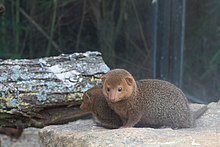
The meerkat or suricate is a small mongoose found in southern Africa. It is characterised by a broad head, large eyes, a pointed snout, long legs, a thin tapering tail, and a brindled coat pattern. The head-and-body length is around 24–35 cm (9.4–13.8 in), and the weight is typically between 0.62 and 0.97 kg. The coat is light grey to yellowish-brown with alternate, poorly defined light and dark bands on the back. Meerkats have foreclaws adapted for digging and have the ability to thermoregulate to survive in their harsh, dry habitat. Three subspecies are recognised.

The Amami rabbit, or Amami no-kuro-usagi, also known as the Ryukyu rabbit is a dark-furred rabbit which is only found in Amami Ōshima and Toku-no-Shima, two small islands between southern Kyūshū and Okinawa in Kagoshima Prefecture in Japan. Often called a living fossil, the Amami rabbit is a living remnant of ancient rabbits that once lived on the Asian mainland, where they died out, remaining only on the two small Japanese islands where they live today.

In animal communication, an alarm signal is an antipredator adaptation in the form of signals emitted by social animals in response to danger. Many primates and birds have elaborate alarm calls for warning conspecifics of approaching predators. For example, the alarm call of the blackbird is a familiar sound in many gardens. Other animals, like fish and insects, may use non-auditory signals, such as chemical messages. Visual signs such as the white tail flashes of many deer have been suggested as alarm signals; they are less likely to be received by conspecifics, so have tended to be treated as a signal to the predator instead.

Kirk's dik-dik is a small antelope native to Eastern Africa and one of four species of dik-dik antelope. It is believed to have six subspecies and possibly a seventh existing in southwest Africa. Dik-diks are herbivores, typically of a fawn color that aids in camouflaging themselves in savannah habitats. According to MacDonald (1985), they are also capable of reaching speeds up to 42 km/hour. The lifespan of Kirk's dik-dik in the wild is typically 5 years, but may surpass 10 years. In captivity, males have been known to live up to 16.5 years, while females have lived up to 18.4 years.

Soemmerring's gazelle, also known as the Abyssinian mohr, is a gazelle species native to the Horn of Africa. The species was described and given its binomen by German physician Philipp Jakob Cretzschmar in 1828. Three subspecies are recognized. It is possibly no longer present in Sudan.

Pousargues's mongoose, also known as the African tropical savannah mongoose, is a mongoose native to Central Africa. It is listed as data deficient on the IUCN Red List as little is known about its distribution and ecology.

The common dwarf mongoose is a mongoose species native to Angola, northern Namibia, KwaZulu-Natal in South Africa, Zambia and East Africa. It is part of the genus Helogale, along with the Ethiopian dwarf mongoose.

Günther's dik-dik is a small antelope found in arid zones of East Africa.

The Somali dwarf shrew is a species of mammal in the family Soricidae. It is found in Ethiopia and Somalia. Its natural habitat is subtropical or tropical dry lowland grassland.

The yellow-spotted rock hyrax or bush hyrax is a species of mammal in the family Procaviidae. It is found in Angola, Botswana, Burundi, the Democratic Republic of the Congo, southern Egypt, Eritrea, Ethiopia, Kenya, Malawi, Mozambique, Rwanda, Somalia, northern South Africa, South Sudan, Sudan, Tanzania, Uganda, Zambia, and Zimbabwe. Its natural habitats are dry savanna and rocky areas. Hyrax comes from the Greek word ὕραξ, or shrew-mouse.

Helogale is a genus of the mongoose family (Herpestidae). It consists of two species and 12 subspecies:













